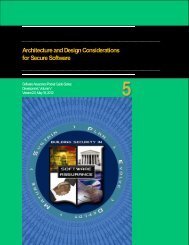Secure Coding SwA Pocket Guide - Build Security In - US-CERT
Secure Coding SwA Pocket Guide - Build Security In - US-CERT
Secure Coding SwA Pocket Guide - Build Security In - US-CERT
Create successful ePaper yourself
Turn your PDF publications into a flip-book with our unique Google optimized e-Paper software.
<strong>In</strong>tegrate Anomaly Awareness<strong>In</strong> most distributed software systems, components maintain a high level of interaction with each other. Abnormal behaviorincludes inaction (i.e., lack of response) in a particular component for an extended period of time, and generation of messagesthat do not follow prescribed protocols. All components should be designed or retrofitted to recognize abnormal behavior patternsthat indicate possible DoS attempts. Place this capability in software developed from scratch and retrofit acquired or reusedcomponents (e.g., by adding anomaly-detection wrappers to monitor the component’s behavior and report detected anomalies).Early detection of the anomalies that are typically associated with a DoS can make mitigation possible before a full DoS occurs.Techniques include containment, graceful degradation, and automatic fail-over. While anomaly awareness alone cannot preventa widespread DoS attack, it can effectively handle isolated DoS events in individual components, as long as detected abnormalbehavior patterns correlate with anomalies that can be handled by the software as a whole.<strong>In</strong>corporate Runtime Error Checking and Safety EnforcementApply runtime protections to prevent buffer overflows in binaries executed under a particular operating system or to analyzecompiled binaries in terms of dynamic runtime security. Apply security wrappers and content validation filters to open-sourcesoftware code and binary executables to minimize the exposure of their vulnerabilities. By and large, security wrappers andvalidation filters are used to add content (input or output) filtering logic to programs that don’t have that logic “built in.” First, thewrappers intercept and analyze input to or output from the “wrapped” program. Next they detect and then remove, transform, orisolate content that is suspected of being malicious (e.g., malicious code) or that contains unsafe constructs, such as very longdata strings (associated with buffer overflows) and command strings associated with escalation of privilege. As a general rule,security wrappers and content validation filters must be custom developed.Use Event MonitorsUse an event—error or anomaly—monitor to ensure that anomalies or errors are detected as soon after the causal event aspossible. Early and accurate detection will enable isolation and diagnosis before erroneous data can propagate to othercomponents. Time and memory availability usually limit the number of program self-checks that can be implemented. At aminimum, checks should occur for all security-critical states. Use risk analysis to establish the basis for defining the optimalcontents and locations of each check.An attacker will quickly move to erase any evidence of an attack. Because of this, in the event of an attack, logs collected by theevent monitor should be promptly sent to a remote server for further analysis.Monitor checks should be non-intrusive; they should not corrupt the process or data being checked. <strong>In</strong> addition, the developershould take particular care when coding logic for monitoring and checking to avoid including exploitable flaws.The effectiveness of event monitors is based on the correctness of assumptions about the structure of the program beingmonitored and the anomalies and errors that are considered likely or unlikely in the program. However as with all assumptions,these may be invalidated under certain conditions.Fail <strong>Secure</strong>lyWhen a system fails, it should do so securely. This typically involves several things:secure defaults (default is to deny access);on failure undo changes and restore to a secure state;always check return values for failure; andin conditional code/filters make sure that there is a default case that does the right thing.The confidentiality and integrity of a system should remain even though availability has been lost. Attackers must not bepermitted to gain access rights to privileged objects during a failure that are normally inaccessible. Upon failing, a system thatSoftware Assurance <strong>Pocket</strong> <strong>Guide</strong> Series:Development Volume VI – Version 2.0, , May 18, 2012<strong>Secure</strong> <strong>Coding</strong>23
















